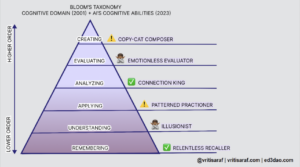SuperHuman Education

By Richard Boyd
Some time in the 21st century, a stand alone, un-augmented mind will be considered handicapped.
It is no secret to anyone who has a smart phone or who has used Google search, that the Internet and search, adeptly utilized, can make an already intelligent person vastly more intelligent. As other technologies like ubiquitous artificial intelligence, intelligent tutors, augmented reality, and game-based learning continue to improve, the digital divide between those who are comfortably fluent with technology and those who are not will create dramatic contrasts in society. There is a revolution under way driven by Moore’s Law (for price performance of computer processing power) and Metcalfe’s Law (the power of networked intelligence) that is changing the competitive landscape and redefining literacy. Those individuals who take advantage of this revolution and gain a comfortable fluency and literacy with these new interfaces will appear superhuman to and outperform those without them. Conversely, those who do not keep pace with technology will appear disabled. This will be true of individuals and organizations as well as nations.
Accessing Analytics
The 2012 Super Bowl, 102 seconds remaining. The New York Giants are trailing the New England Patriots by 2 points. Giants quarterback Eli Manning hands the ball off to running back Ahmad Bradshaw, who streaks up the middle to the goal line… and freezes. No one from the New England Patriots tries to tackle him. His team mates are shouting at him, “Don’t score!” A confused world watches, as Bradshaw finally is unable to overcome his lifelong training, and slowly tips and falls into the end zone. Comedian Billy Crystal called it the “tush down”. Others in the media called it “the reluctant touchdown”. However history decides to record this unusual moment in sports, there is no denying that it was a harbinger of what is to come in every area of human endeavor. Humans were not making the decision on either sideline. Analytical algorithms on computers had replaced human intuition. Increasingly, our lives are being governed by machines.
Automation
We are becoming more comfortable outsourcing what were once human jobs to automation. Robotic manufacturing has grown dramatically in the last decade. There has been a lot of attention on outsourcing of American jobs abroad, but this is only a distraction from what is really happening. Outsourcing to human workers in other countries is a short term phenomenon, soon to be replaced by outsourcing to automation. We have gradually grown more comfortable replacing human workers with automated systems. Three decades ago automated bank teller machines were an enormous improvement in convenience and were embraced gladly. Now automated check out lines in grocery stores , automated airline check in agents, stock traders, self-driving automobiles and aircraft are emerging and dramatically improving efficiency, productivity and safety.
When automation began to replace farm workers over a century ago, there were only minor protests. The industrial age was replacing farm jobs with manufacturing jobs and the phenomenon was gradual compared to the disruption we are seeing today. In 1800, 90% of the American work force worked in agriculture. In 1900, that number had declined to 41%. In 2000, it was around 2%. Today there are more app developers than farmers in the United States. Seven years ago the job of app development was relatively unknown and unneeded. Android smart phones and iphones had not yet reached the market.
Education, the practice of embedding information and systems of thinking and acting into human beings, is beginning to appear as one of the final bastions of resistance to the rise of automation. Across the country and around the world, classroom instruction still looks and feels much as it did over a century ago. A solitary teacher stands up in front of a passive collection of seated students and lectures to them in an analog stream of words, occasionally augmented by symbols and images scratched on a board. Moore’s law has an amazing exponential effect on every industry it touches, except education, where there are systems and policies that appear to slow technology adoption.
The proper role of technology in education
Some educators have argued, and rightfully so, that adopting technology has all too often proven to be a Faustian bargain, where the cost and difficulty of managing the insertion of computers, networks and smart boards into class rooms proves more costly than any benefits gained. This has been true of early adoption cycles for technology in every industry. Since 2008 the influence of open source technologies and the ubiquity of network access have been reducing the friction for technology adoption in classrooms. On top of that, the interface is becoming more ambient and usable. As these trends continue, we should see more technology adoption. Until now, in the information age, we have spent a great deal of effort and time conforming ourselves to the technologies we have created to assist us. We have learned to type, use computer software and tether ourselves to devices. In the next phase of the information age, the technology we have created will begin to serve us. Technology will be more of an asset and tool and less of a cost and liability as usability, affordability and availability increase.
The Role of Teachers:
Teachers will become mediators between students, knowledge and technology. As technologies like game-based learning and intelligent tutors continue to improve, the role of the teacher will continue to migrate to one of mediator or guide. This is an essential and critical role, where teachers become even more important. Teachers who have a good command of digital tools will be highly sought after by students and administrators. A recent Pew Research study revealed that teachers are already more digitally fluent than the broad population. We need to assign effort and resources to making them even more so. They must be super humanly ready to amplify student knowledge with the best smart search, intelligent tutors and game-based learning available.
Educators will become the curators and validators of the best tools, data sources and methods available.
The Role of Government:
Over the last decade the call for more privatization of education has become shrill. The baby boomer generation, a product of the very government funded education system they now decry, are the most strident in their call for privatization. There is a reason Thomas Jefferson was so adamant about publicly funding education. It wasn’t about jobs and careers. It was about civic minded citizenry being the foundation of any healthy democracy. Today it is about flexible and generative thinking in an age of exponential change and existential threats. Like healthcare, warfare, energy and the environment, there are certain societal endeavors best left to the organizing powers of government. Education is one of them. I firmly support Secretary of Education Arne Duncan’s call for the Federal Government to create an ARPA for Education. In this century of exponential change and existential threats, individuals, organizations and nations with the most digitally fluent, collaborative, innovative and generative thinking people will thrive.
Note to the Education Luddites:
I was recently discussing this thesis with someone who said they were very comfortable without having to master technology. My response was, if you have enough resources, you could make the decision to go and live in France. You might also decide to not learn French. You would survive. You would be able to get by, but you would never be a full participant in the community. If you ever found yourself in a competitive situation you would fail. Remaining digitally un-augmented will leave you at a disadvantage measured in dozens of IQ points.
The Student Imperative: Learn to Code, Save the World
It does not appear that our children need much coaxing to embrace technology. Marc Prensky and Don Tapscott and many others have thoroughly documented the deep comfort and preference the “Digital Natives” and “Millenials” have for technology. But leaving them to their own devices (pun intended) without guidance from parents and educators is perilous. What we need is more structure around the specific skills that will allow them to become more fluent with these tools and able to use them in productive ways. Also, learning to code will be a critical skill. Not because everyone will need to write code, but because understanding machine intelligence will improve the symbiosis of human and machine to solve problems together. Learning to code may be as important to structuring thinking in the SuperHuman age as learning algebra was to the industrial age.
One more thing: Balance
The best chess player in the world is not a human; nor is it a computer, but a team of humans working with computers and perfected algorithms. The 21st century imperative is determining how to achieve the right balance between humans and automation to optimize outcomes. Those who do master this balance and achieve a comfortable fluency with automation, network intelligence, simulation and analytics will not only outperform those who do not, but they will begin to appear super human.
The biggest issue for the 21st century, for individuals and organizations alike, is determining how to achieve the correct balance between humans and automation to optimize outcomes.
About the Author:
Richard Boyd is an entrepreneur, investor, author and speaker on a range of topics from education to healthcare to virtual worlds, computer gaming and human/ computer interfaces. The driving problem for his career is to see industry and individuals take full advantage of the power of today’s computing and networked intelligence






Dale McClure
Two comments to keep our perspective. Automation and the information, it makes available are tools, and have value when used by humans to meet human needs. Innovation by humans, takes tools developed earlier, and adds to them. By today’s standards, the rather simple computer mouse I used to point to this box is an excellent example. I dare say no one person could fabricate all the components, then combine them together into this mouse; much less reinvent all those components. Just how far back does my computer mouse leverage tools innovated by forefathers? The basic shape goes back to the Stone Age in which a human, wanting to crack open a nut or shape a rock into a tool, maybe a spear head, found a stone roughly the shape of my mouse to use as a chipping tool, to open the nut or shape the spear head. Just as that Stone Age person could never have conceived that his tool would lead to the computer mouse I'm using, we can't conceive how the information technologies that makes for super humans today, will be simple components of the tools humans will have in the future. The first human to pick up a rock and use it to crack open a nut, then build a spear, was a super human to the hungry folks trying to open nuts with their hands and teeth.
Second; like Thomas Jefferson, I think most citizens, including us baby boomers, feel that schools should be available to all and be state run. The interest in privatization comes from the gross amount of overhead/bloat, adding no value in state, local and federal government. Clearly we expect and need efficient innovators, working for our common good, at all levels of government. Until we are “super human” enough fix that problem, we will continue to see wise people look toward private enterprise for better answers.
richard
https://youtu.be/8uzq_A8skhs
See the factory of the Future at the link above